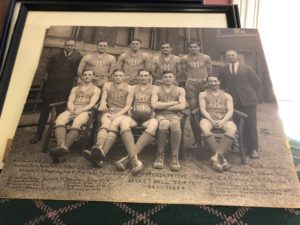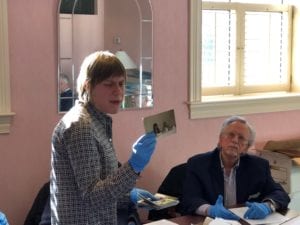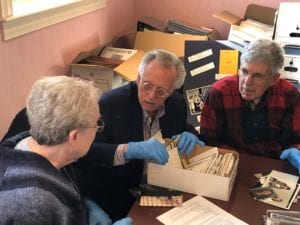
This turn-of-the-20th century team photo of a JCC basketball team is one thousand of photos being sorted, group and identitfied (when possible) by the Archives Governance Committee.
In the basement of the Standard Country Club, 11 people sat together in a small room at three tables pushed together, hemmed in by stacks of boxes.
In the adjoining hallway–more boxes.
They all contained photos – albums of photos, folders of photos, news photos, photos on poster boards.
The dozens of boxes easily contained thousands of photos.
That doesn’t even count the countless strips of negatives, stacks of slides, newspaper clippings from long ago.
The job of these 11 volunteers? Sort through these images, put them into order, discard the duplicates, get them ready to be identified – whenever they can be identified. It’s the kind of hard work and commitment they have been putting in for a solid year.
Welcome to phase II of The Jewish Community of Louisville Archives Governance Committee’s on endeavor to process and eventually digitize JCL papers, pictures and media into an organized and searchable resource.
Phase II of the process started in earnest on Dec. 4 at the Standard Club. Abby Glogower, curator of Jewish collections and Jewish Community Archive at the Filson Historical Society, which is creating an online archive, is guiding the effort.
Phase I of the archiving project, a yearlong effort that involved culling and organizing JCL documents, is continuing.
But Fred Joseph, co-chair of the archives committee, said phase II will make phase I look like a walk in the park.
“Preserving our Jewish history is an important endeavor and couldn’t have been done without the countless and selfless hours of the committee volunteers,” he said.
At the same time, the Filson has been working on other collections, including the records of Jewish Hospital. It also has contracted with a company in New York to digitize the back issues of Community on a searchable internet platform, which the museum will host on its website. So far, papers from the ‘70s and ‘80s have been digitized, while the 90s are being processed now.

Abby Glogower of the Filson Historical Society discusses how the photo-sorting stage of the archiving process should work as Frank Weisberg, co-chair of the committee, listens.
The JCL initiated the archives project, using a grant from the Jewish Heritage Fund for Excellence, which pays for staff, storage space and archival supplies. The Filson is working with the Archives Committee.
Separately, the Filson also is collecting historical materials from Jewish individuals, families and organizations. It is collaborating with the Jewish Studies programs at the universities of Louisville and Kentucky, using those collections in teaching and research, and designing exhibits, programs, and workshops.
Eying the stacks of boxes at the Standard Club, including several framed photographs that once hung on some forgotten wall, Joseph described the project that lay ahead.
“We went through about 400 boxes of paper,” he said of phase I. “That was easier than this, because the generations that could identify them (the photos) are gone.”
Glogower also acknowledged the enormity of the job.
“The amount of material itself is overwhelming,” she said, “and there’s more material we’re learning about.”
But it has to be done, Glogower said. These documents, ledgers, minutes, photos, press releases, newspapers and other records constitute the collective record of Jewish Louisville – a memory of sorts – that becomes even more important as generations of living memory pass away.
“The records of the JCL and the other Jewish collections we are building at the Filson have enormous potential for increasing knowledge about ourselves and others and the issues we face in the present.”
As the committee members donned blue latex gloves, they discussed how best to begin the job.
Some wanted to tackle the stack of poster boards in the corner, all mounted with photos.
Some of the boards had sheets of papers taped to their backs with names of people in the photos – the product of an earlier effort to identify the images.
“Some of the work is done,” said Sheila Steinman Wallace, editor emeritus of Community and a member of the committee.
But Glogower said there were “preservation issues” with the poster boards.
“Glue is very destructive in the long term, so is the non-archival paper board to which the items are pasted,” she said. “Chemicals in the glue and the paper will hasten the degradation of the things we are trying to save.”
So they started with the boxes.
Demonstrating how the process should work, Glogower opened one box and started sorting through it herself for the committee’s benefit. Most of its contents were photos of a trip to Israel, but some were of completely different subjects. Those shots Glogower deposited in a stack on the tabletop, which she called her “wild pile.” They would be sorted through later.
The box also contained several strips of negatives, which the Filson can preserve, she said, though it wasn’t immediately clear if they matched up with the prints in the box.
Shuffling through the photos one by one, Glogower urged the committee to concentrate on which images should go into what envelopes.
“I’m not thinking too hard right now about who’s in it (the photo) or what they’re doing,” she said. That, too, will happen later.
She did tell committee members to look for “clues” in the images that may help in organizing them. She held up one shot of a woman seated in a chair, holding a basketball, with balloons decorating the backdrop behind her – all signs that this was a Super Sunday event.
Other shots were easier to identify, like two turn-of- the-century (the 20th century) photos of JCC basketball teams, complete with names of the teams and players scrawled at the bottom, or a year painted on one of the balls (1910).
Many photos were snapshots. Many others were shot for use in Community, according to Wallace.
And still others will be discarded, like a copy of a UJA Press Service from the 1970s or 80s of an emigrant from the Soviet Union donning a gas mask at Ben Gurion Airport in Israel. Since there’s no discernable connection to Louisville, it probably won’t be archived.
Glogower hopes the committee can have the photos sorted and ready for review by Filson’s curatorial staff by mid-March.
The multi-year endeavor to arrange and catalogue all the materials will eventually result in a resource accessible to the public.
But that doesn’t mean every document or image will be searchable, she warned.
“Our finding aids and catalogs make an archive’s materials searchable online, so in that sense they are digital,” Glogower said. “But will we be actually digitizing every item in the collections? Absolutely not. No archive does this because it is not possible.”



